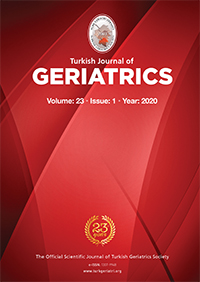2Baskent University, Faculty of Medicine, Department of Cardiology, Adana, TURKEY
3Baskent University, Faculty of Medicine, Department of Nephrology, Adana, TURKEY DOI : 10.31086/tjgeri.2020.136 Introduction: Although atherosclerotic cardiovascular diseases and cardiovascular risks are known to increase in patients with end-stage renal disease, it is not clear whether these risks increase in the geriatric patient population as well. This study aims to evaluate these risks in geriatric patients with end-stage renal disease by evaluating epicardial fat and carotid and femoral intima-media thicknesses, known as markers, for subclinical atherosclerosis and cardiovascular risks.
Materials and Methods: This cross-sectional study included 52 patients who started to receive chronic hemodialysis treatment after the age of 65 years (mean age 73.92±5.63) years with end-stage renal failure and 51 healthy volunteers (mean age: 74.49±4.63 years). Epicardial fat and carotid and femoral intima-media thicknesses were measured and compared between these groups.
Results: Carotid intima-media and epicardial fat thicknesses were significantly higher in the patient group than in the control group (0.91±0.08 vs. 0.71±0.1 mm, p<0.001 and 0.84±0.17 vs. 0.75±0.17 cm, p=0.01, respectively). However, no significant difference was observed in femoral intima-media thickness between the two groups (0.58±0.07 vs. 0.56±0.97 mm, p=0.266). Correlation analysis revealed a significant positive correlation between the duration of dialysis and epicardial fat and carotid intima-media thicknesses (r=0.611, p<0.001 and r=0.337, p=0.015, respectively). Furthermore, regression analysis revealed a significant relationship between the duration of dialysis and carotid intima-media thickness (?=0.657, p=0.001).
Conclusion: Epicardial fat and carotid intima-media thicknesses increase in geriatric patients with end-stage renal disease but with no significant changes in femoral intima-media thickness, indirectly suggesting that subclinical atherosclerosis and cardiovascular risks are increased in these patients.
Keywords : Atherosclerosis; Echocardiography; Kidney disease; Ultrasonography
